单细胞测序(测序公司培训)PPT精选文档
测序PPT

生工Sangon Biotech
α-互补
• 即:携带lacz’基因的质粒编码的α肽链和宿 主编码的N端有缺陷的β半乳糖苷酶突变体 互补,产生完整β半乳糖苷酶的能力——把 X-gal分解成蓝色物质的能力。
生工Sangon Biotech
TA克隆的优点
• 1、不需使用含限制酶序列的引物
• 2、不需要把PCR产物优化 • 3、不需要把PCR产物平末端处理 • 4、不需要把PCR产物加接头
生工Sangon Biotech
克隆测序要求
• 1、PCR以纯化:浓度≥20ng/ul,体积20ul • 2、PCR未纯化:浓度≥50ng/ul,体积25ul • 3、务必订单上注明PCR所用引物序列,以 便用于克隆结果的核对分析 • 4、克隆片段信息:名称、大小、样品是否 带A尾以及PCR产物类型
• 4、质
粒:20ul,浓度>100ng
生工Sangon Biotech
样品处理
• 1、菌液:
过夜培养 质粒提取 鉴定 反应
结果报告
序列分析
上机测序
生工Sangon Biotech
样品处理
• 2、PCR未纯化:
纯 化 鉴定 反 应
结果报告
序列分析
上机测序
生工Sangon Biotech
样品处理
生工Sangon Biotech
样本要求
• 1、甘油菌或穿刺菌:请注明其培养基、抗 生素抗性、载体名称及是否需要诱导等信 息;
• 2、质粒DNA:浓度需≥ 100 ng/μl,总量≥ 1 μg,OD 值介于1.80~2.00 之间,并确保 DNA 没有发生降解。
生工Sangon Biotech
流
挑取克隆、液体 LB培养基培养
单细胞测序
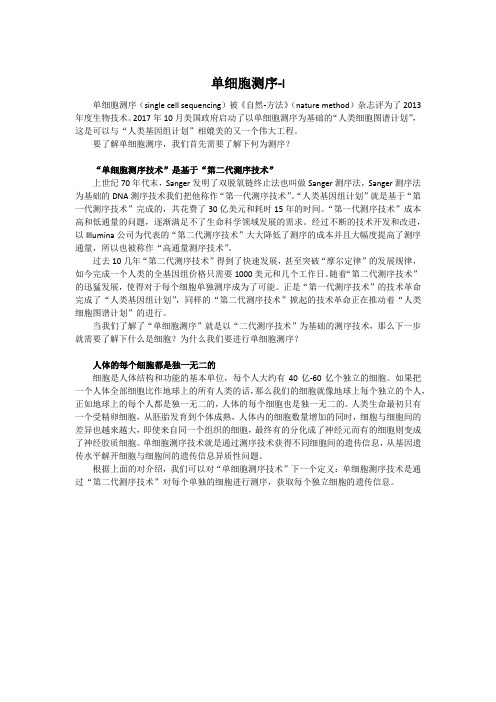
单细胞测序-I单细胞测序(single cell sequencing)被《自然-方法》(nature method)杂志评为了2013年度生物技术。
2017年10月美国政府启动了以单细胞测序为基础的“人类细胞图谱计划”,这是可以与“人类基因组计划”相媲美的又一个伟大工程。
要了解单细胞测序,我们首先需要了解下何为测序?“单细胞测序技术”是基于“第二代测序技术”上世纪70年代末,Sanger发明了双脱氧链终止法也叫做Sanger测序法,Sanger测序法为基础的DNA测序技术我们把他称作“第一代测序技术”。
“人类基因组计划”就是基于“第一代测序技术”完成的,共花费了30亿美元和耗时15年的时间。
“第一代测序技术”成本高和低通量的问题,逐渐满足不了生命科学领域发展的需求。
经过不断的技术开发和改进,以Illumina公司为代表的“第二代测序技术”大大降低了测序的成本并且大幅度提高了测序通量,所以也被称作“高通量测序技术”。
过去10几年“第二代测序技术”得到了快速发展,甚至突破“摩尔定律”的发展规律,如今完成一个人类的全基因组价格只需要1000美元和几个工作日。
随着“第二代测序技术”的迅猛发展,使得对于每个细胞单独测序成为了可能。
正是“第一代测序技术”的技术革命完成了“人类基因组计划”,同样的“第二代测序技术”掀起的技术革命正在推动着“人类细胞图谱计划”的进行。
当我们了解了“单细胞测序”就是以“二代测序技术”为基础的测序技术,那么下一步就需要了解下什么是细胞?为什么我们要进行单细胞测序?人体的每个细胞都是独一无二的细胞是人体结构和功能的基本单位,每个人大约有40亿-60亿个独立的细胞。
如果把一个人体全部细胞比作地球上的所有人类的话,那么我们的细胞就像地球上每个独立的个人,正如地球上的每个人都是独一无二的,人体的每个细胞也是独一无二的。
人类生命最初只有一个受精卵细胞,从胚胎发育到个体成熟,人体内的细胞数量增加的同时,细胞与细胞间的差异也越来越大,即使来自同一个组织的细胞,最终有的分化成了神经元而有的细胞则变成了神经胶质细胞。
单细胞测序技术(singlecellsequencing)
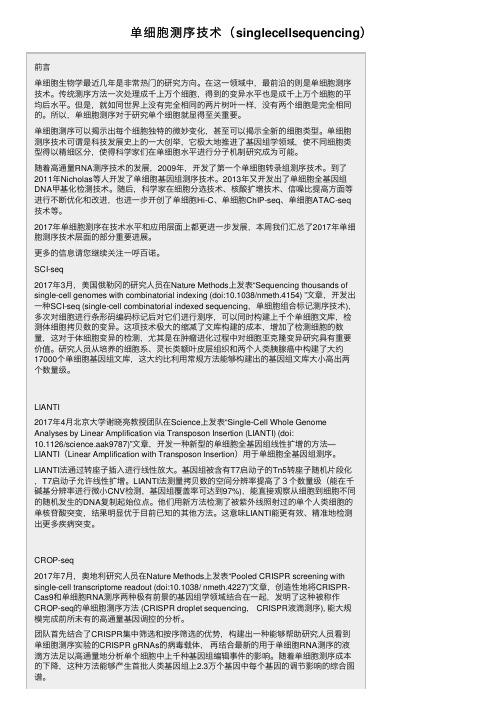
单细胞测序技术(singlecellsequencing)前⾔单细胞⽣物学最近⼏年是⾮常热门的研究⽅向。
在这⼀领域中,最前沿的则是单细胞测序技术。
传统测序⽅法⼀次处理成千上万个细胞,得到的变异⽔平也是成千上万个细胞的平均后⽔平。
但是,就如同世界上没有完全相同的两⽚树叶⼀样,没有两个细胞是完全相同的。
所以,单细胞测序对于研究单个细胞就显得⾄关重要。
单细胞测序可以揭⽰出每个细胞独特的微妙变化,甚⾄可以揭⽰全新的细胞类型。
单细胞测序技术可谓是科技发展史上的⼀⼤创举,它极⼤地推进了基因组学领域,使不同细胞类型得以精细区分,使得科学家们在单细胞⽔平进⾏分⼦机制研究成为可能。
随着⾼通量RNA测序技术的发展,2009年,开发了第⼀个单细胞转录组测序技术。
到了2011年Nicholas等⼈开发了单细胞基因组测序技术。
2013年⼜开发出了单细胞全基因组DNA甲基化检测技术。
随后,科学家在细胞分选技术、核酸扩增技术、信噪⽐提⾼⽅⾯等进⾏不断优化和改进,也进⼀步开创了单细胞Hi-C、单细胞ChIP-seq、单细胞ATAC-seq技术等。
2017年单细胞测序在技术⽔平和应⽤层⾯上都更进⼀步发展,本周我们汇总了2017年单细胞测序技术层⾯的部分重要进展。
更多的信息请您继续关注⼀呼百诺。
SCI-seq2017年3⽉,美国俄勒冈的研究⼈员在Nature Methods上发表“Sequencing thousands of single-cell genomes with combinatorial indexing (doi:10.1038/nmeth.4154) ”⽂章,开发出⼀种SCI-seq (single-cell combinatorial indexed sequencing,单细胞组合标记测序技术),多次对细胞进⾏条形码编码标记后对它们进⾏测序,可以同时构建上千个单细胞⽂库,检测体细胞拷贝数的变异。
这项技术极⼤的缩减了⽂库构建的成本,增加了检测细胞的数量,这对于体细胞变异的检测,尤其是在肿瘤进化过程中对细胞亚克隆变异研究具有重要价值。
单细胞测序

2、样本高度异质,细胞之间存在重要差异
肿瘤遗传异质性研究,如化疗前后细胞种群及疗效分析 神经元的差异机制 辐射前后细胞差异分析
B: 当延伸遇到另一条新链随 机引物时,Φ29 DNA聚合酶替 换掉引物继续延伸,形成支链 结构,新的引物会在支链上重 新结合延伸。
B
MALBAC、MDA、Bulk比较
MALBAC技术方法
• 结果
• Cnv图
MALBAC技术方法
单细胞测序技术应用
1、样本稀少,用常规方法无法进行基因组或转录组分析
微流控芯片分离技术
• 利用微加工技术,在硅、玻璃、聚二 甲基硅氧烷等材料上,根据需要制作各 种结构、大小的微米量级的管道进行实 验,结合微流控技术对细胞进行分离。 (亲和性、物理特征、电学性能、免疫 磁珠)
优势:通量大,检测灵敏度高、分析速度快、自动高效。
劣势:微流控自身限制;芯片设计难度大。
单细胞全基因组扩增技术
单细胞测序技术
单细胞测序技术背景 单细胞分离技术
单细胞全基因组扩增技术 单细胞测序技术应用
单细胞测序技术背景
• 大量细胞测序反映的是细胞群体中信号表达的均值, 或者代表其中在数量上占优势的细胞信息,单个细胞 的独有细胞特性被掩盖或者忽略。
• 从单个细胞获取完整的基因组信息的应用场景增多, 如:循环肿瘤细胞转录组分析、人胚胎发生最早期的 分化特征研究等。
优势:高准确度、高灵敏度、高通量、 技术成熟、标准统一。
劣势:需要大量的悬浮细胞作为原始材料,会影响低丰度细胞亚 群的产出;快速液流影响细胞活性和状态。
梯度稀释分离
• 通过将细胞进行梯度稀释,最终得到 单个细胞。适用于样本可以培养的研究 中,如单个大肠杆菌与原绿球藻进行基 因组测序。
《NGS基础培训》课件

诊断罕见遗传病
通过分析患者的基因变异,对罕见的遗传病进行确诊和病理 分析。
预测遗传风险
通过对家族遗传史的研究,预测患者或亲属患某种遗传疾病 的风险。
肿瘤个性化治疗
靶向治疗
通过基因测序找到肿瘤的特异基因变异,设计个性化治疗方案,提高治疗效 果和减少副作用。
免疫治疗
分析肿瘤细胞的免疫逃逸机制,为患者提供更加精准的免疫治疗。
单细胞RNA测序
通过对单个细胞进行RNA测序,研究细胞异质性和基因表达的复杂性,具有 更高的灵敏度和分辨率。
单细胞DNA测序
通过对单个细胞进行DNA测序,研究基因组变异和遗传多样性,具有更高的 灵敏度和分辨率。
空间转录组测序技术
空间RNA测序
通过对组织样本进行空间定位,研究基因表达的空间分布和细胞异质性,为研究 复杂的生物组织提供新的工具。
VS
详细描述
序列组装是将测序得到的数千至上百万条 序列拼接成较大片段的过程,需要使用高 效的算法和计算资源。基因组构建是在序 列组装完成后,利用生物信息学手段将获 得的基因组组装成完整的图谱。这些步骤 对于研究生物体的基因组变异、基因结构 和功能等具有重要意义。
03
ngs在临床医学中的应用
遗传疾病的诊断与预测
数据质量控制与处理
数据质量评估
采用FASTQC等工具对数据质量进行评估,确保数据质量符 合要求。
数据过滤与去噪
使用Trimmomatic、Novoalign等工具进行数据过滤和去噪 ,以提高数据质量。
基因变异检测与注释
基因变异检测方法
采用SOAPsnp、GATK等工具进行基因变异检测,并依据SNP位点在基因组 上的位置进行注释。
《ngs基础培训》课件
单细胞测序技术课件

逆转录与cDNA合成 使用逆转录酶将建原理
将逆转录合成的cDNA进行一 录
• 单细胞测序技术概述 • 单细胞测序技术原理 • 单细胞测序实验设计 • 单细胞测序数据分析 • 单细胞测序技术的应用案例 • 单细胞测序技术的未来发展与挑战
contents
01
单细胞测序技术概述
定义与特点
定义
单细胞测序技术是一种高通量的分子 生物学技术,可以对单个细胞进行基 因组、转录组或表观组测序,以揭示 进行酶切、连接和文 库构建,以便后续的测序 分析。
技术优势与局限性
优势
能够对单个细胞进行基因组或转录组 分析,分辨率高,能够揭示细胞异质 性。
局限性
由于技术复杂度高,成本较高,且存 在一定的误差率。
03
单细胞测序实验设计
实验准备
确定研究目标
在开始单细胞测序实验前,需要明确研究目标,例如鉴定特定组 织或疾病中的细胞类型、分析细胞发育过程等。
预测模型构建
基于单细胞测序数据,构建预测模型,用于 疾病诊断、药物筛选和个性化治疗等。
技术伦理与法规问题
数据隐私保护
确保单细胞测序数据的隐私保护,防止数据泄露和 滥用。
伦理审查与知情同意
建立严格的伦理审查机制,确保单细胞测序技术的 合理使用和伦理规范。
法规监管
制定相关法规和政策,规范单细胞测序技术的研发 和应用,保障科技发展的安全和可控性。
应用领域
基础研究
01
用于揭示细胞发育、分化、功能和相互作用的机制,以及探索
疾病发生、发展和治疗的分子机制。
单细胞测序技术PPT培训课件

扩增引物 Phi 29 DNA聚合酶 基因组模板DNA
MALBAC法扩增
5’端有通用 扩增序列的 DNA片段
第一个循环下来,得到的是一批5’端有通用扩增序列的DNA片段
单细胞测序技 术
背景
过去二十几年里,随着基因测序技术水平的提高以及千人基因组计划、 癌症基因组计划等重大国际合作项目的相继开展,基因组研究日渐被推向 高潮。
我们能够得到全基因组序列信息,但是对其进行研究得到的结果只是 一群细胞中信号的平均值,或者只代表其中占优势数量的细胞信息,单个 细胞独有的特性被忽视。另外有些样品稀少无法在实验室培养,样品量不 足以进行全基因组分析,因此全基因组测序遇到难题。
第二个要解决的难题,这里是利用Phi29聚合酶能一次在模板上聚合出多个新链 的功能来达到这个目的。在5轮的扩增之后,每个模板都会有5*n2个扩增片段, 这样就可解决的问题,高效率扩增,还是利用了Phi29聚合酶的一次得到多个扩 增片段的效果来达成的。
请大家批评指正! 谢谢!
MDA扩增图
MDA方法的技术核心是用Phi29DNA聚合酶来进行直接的扩增,Phi29DNA聚合酶可 以把双链DNA进行解链,然后在常温条件下就把原始模板进行大量扩增
两种方法比较
MDA的特点: 扩增效率更高,实验方法简单
MALBAC的特点: 扩增均一性更好; 得到的扩增DNA的量相对较少,或者说他的扩增效率相对较低
58℃退链火内杂交
完整扩增产物,自我 锁定,无法扩增
这样3’端的序列就不能与新的、游离的引物发生杂交,也就不会引发 新的、发始于3’端的扩增,这样就避免了完整扩增产物的指数扩增
单细胞测序技术及应用

CAR-T细胞的克隆动力学和单细胞转录谱分析
发表时间:2020 研究对象:B细胞恶性肿瘤 分离方法:流式细胞荧光分选
10X Genomics 建库策略:51、TCRB测序显示,CAR-T细胞克 隆多样性在IPs中最高,输注后下降。 2、scRNA-seq表明,输注后扩增的 克隆主要来源于输注的细胞毒性和 增殖基因表达更高的簇。 3、发现了与CAR-T细胞注射后行为 相关的转录机制。
80000个细胞; • 细胞捕获效率高:单个细胞捕获效率高达65%,可准确鉴别稀有细胞类型,利于稀有样本或小细胞量类型样本研究; • 多态率低:多态率(同一个GEM包含2个及2个以上细胞)低于0.9%/1000细胞。
样品前处理--制备细胞悬液
细胞清洗与过滤 细胞计数
活力评估
样品要求及悬浮液制备过程中注意事项
细胞过滤(除碎片、死细胞) 细胞计数>1000 cells/μl 上机
分离小鼠胚胎神经组织
神经组织
去除培养基至刚好没过组织
2 mL木瓜蛋白酶溶液 37 ℃,20 min孵育,
并轻轻搅拌 研磨组织
沉淀碎片 细胞清洗及过滤
细胞计数 上机
肿瘤组织
预冷1XDPBS清洗肿瘤 组织并剪碎
加入1X红细胞去除液
单细胞分析的扩增方法
转录组 基因组 表观基因组 蛋白质检测
扩增策略 全长RNA-Seq、mRNA末端标签扩增、靶向panel、IR-Seq MDA、MALBAC、DOP-PCR、靶向panel ATAC-seq、Hi成后进行质检及测序。细胞清洗及过滤
-20℃孵育30 min
细胞计数
-20℃或-80℃储存(6周以内) 或立即进行下一步
上机
苔原原生质体悬浮液
10X单细胞转录组测序原理和文库构建注意要点(PPT课件)
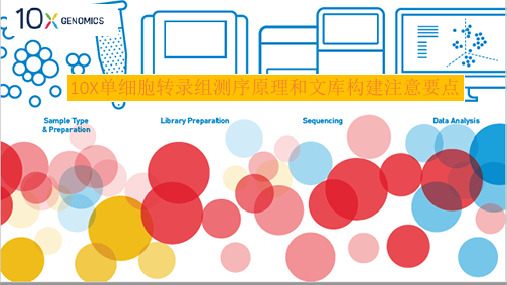
7
10
g/运行Chromium Controller h/转移GEMs
根据建库起始量计算循环数,Index 核对无误。 同上一步双端纯化
9
10
常见问题
Q1:细胞悬液中杂质较多,一方面会影响计数的不准确,细胞浓度偏高,细胞活性偏低; 另一方面会导致芯片的堵塞。
Q2:细胞直径较小(~5um),不在计数仪有效计数的大小范围;细胞小,染色后容易 被当成死细胞计数,导致细胞活性比实际的活性低。
手持芯片边缘将芯片放入芯片架,样本数不足8个,
需要向用不到的通道内加入50%甘油,不要向回收
孔中加入50%的甘油
组织解离
①②③④⑤⑥⑦⑧
6
10
e/ 混合单细胞悬液、Master Mix和水 根据目标捕获细胞数和细胞浓度确定上样体积和水 的体积,先向Mix中加入水再加细胞悬液,细胞悬液 加入Master Mix前用移液器重悬细胞悬液。不要直接 混合细胞和水。
细胞浓度范围:700-1200 cells/ul 细胞活性:≥80%
血液提取、磁珠纯化、流式分选、组织解离等。 b/细胞活性和浓度的测定
用台盼蓝对细胞进行染色,用细胞计数仪进行细胞活
性和浓度的计数;细胞悬液不宜在冰上放太久,30
分 c/准钟备内单使细用胞最M佳a。ster Mix
提前将试剂拿出化冻备用,在冰上配置Master Mix。 d/组装芯片
• 定点编辑基因的细胞水平研究
科普讲堂一文讲明白什么是单细胞测序

科普讲堂一文讲明白什么是单细胞测序简介单细胞测序技术,简单来说,就是在单个细胞水平上,对基因组、转录组及表观基因组水平进行测序分析的技术。
传统的测序,是在多细胞基础上进行的,实际上得到的是一堆细胞中信号的均值,丢失了细胞异质性(细胞之间的差异)的信息。
而单细胞测序技术能够检出混杂样品测序所无法得到的异质性信息,从而很好的解决了这一问题。
图1 单细胞转录组测序示意图单细胞测序技术自从2009年首次问世,在这十几年以来持续不断地发展。
尤其是近几年,单细胞测序出现了爆发式的发展和普及。
2011年,《Nature Methods》杂志将单细胞研究方法列为未来几年最值得关注的技术领域之一。
2013年,《Science》杂志将单细胞测序列为年度最值得关注的六大领域榜首,《Nature Methods》杂志将单细胞测序的应用列为2013年年度最重要的方法学进展。
2017年10月16日,与“人类基因组计划” 相媲美的“人类细胞图谱计划” 首批拟资助的38个项目正式公布,引爆单细胞测序新时代。
单细胞表达谱测序与bulk RNA测序对比传统的二代测序中,最为人熟知的就要数RNA-seq了(图2)。
RNA-seq是提取组织、器官或一群细胞的混合RNA(bulk RNA)进行测序,能够得到的是一群细胞的转录组的平均数据,细胞群体中单个细胞的特异性信息往往被掩盖(比如特异表达的基因或RNA不同的剪接体)。
而随着对生物结构功能的深入研究,人们越来越清楚地认识到,哪怕看似相同的细胞群,细胞之间的转录组表达水平也是存在差异的。
以肿瘤为例,肿瘤中心的细胞,肿块边缘的细胞和肿块周围的细胞,乃至远端转移的细胞,其转录组等遗传信息一定是存在差异的,而传统的研究手段通常将整个肿块整体进行研究,或者将肿块简单分区分割,得到每一部分细胞基因表达的平均值,丢失了每个细胞的异质性信息,使科研人员对肿瘤微环境中各种细胞转录组表达及免疫功能的理解和认识始终无法深入。
单细胞测序技术相关知识点
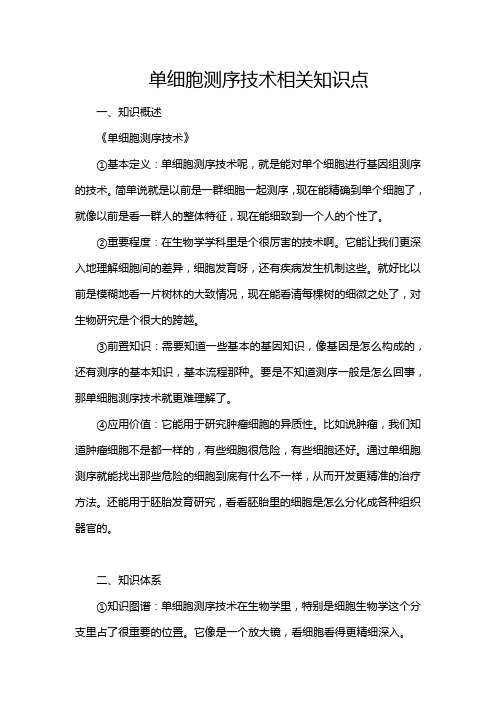
单细胞测序技术相关知识点一、知识概述《单细胞测序技术》①基本定义:单细胞测序技术呢,就是能对单个细胞进行基因组测序的技术。
简单说就是以前是一群细胞一起测序,现在能精确到单个细胞了,就像以前是看一群人的整体特征,现在能细致到一个人的个性了。
②重要程度:在生物学学科里是个很厉害的技术啊。
它能让我们更深入地理解细胞间的差异,细胞发育呀,还有疾病发生机制这些。
就好比以前是模糊地看一片树林的大致情况,现在能看清每棵树的细微之处了,对生物研究是个很大的跨越。
③前置知识:需要知道一些基本的基因知识,像基因是怎么构成的,还有测序的基本知识,基本流程那种。
要是不知道测序一般是怎么回事,那单细胞测序技术就更难理解了。
④应用价值:它能用于研究肿瘤细胞的异质性。
比如说肿瘤,我们知道肿瘤细胞不是都一样的,有些细胞很危险,有些细胞还好。
通过单细胞测序就能找出那些危险的细胞到底有什么不一样,从而开发更精准的治疗方法。
还能用于胚胎发育研究,看看胚胎里的细胞是怎么分化成各种组织器官的。
二、知识体系①知识图谱:单细胞测序技术在生物学里,特别是细胞生物学这个分支里占了很重要的位置。
它像是一个放大镜,看细胞看得更精细深入。
②关联知识:和基因编辑技术有关联,因为都涉及基因层面的操作研究。
也和细胞培养技术有关,毕竟得有细胞来源才能做单细胞测序。
③重难点分析:掌握难度嘛,说实话我觉得它概念理解不容易,因为涉及到很多微观的东西。
然后分析结果也不轻松,数据很多很复杂。
关键点就是准确地采集单细胞,还有很好地分析那些测序数据。
④考点分析:考试中要是考细胞相关的,挺重要的。
可能考查单细胞测序技术原理,或者给个细胞相关疾病的场景,问如何用单细胞测序技术解决问题。
三、详细讲解【理论概念类】①概念辨析:单细胞测序技术核心就是精确到单个细胞的基因测序,和传统测序相比,传统测序把细胞当一个整体测,它是一个一个来。
就像数一堆硬币,传统只能称出一堆的重量,单细胞测序能数清楚每个硬币。
单细胞测序 项目-概述说明以及解释

单细胞测序项目-概述说明以及解释1.引言1.1 概述概述:单细胞测序是一种高级技术,能够对单个细胞进行基因组和转录组的分析。
通过单细胞测序技术,我们可以深入了解细胞之间的差异性和多样性,揭示细胞的功能和相互作用。
这种技术在生物研究领域具有重要的应用前景,可以促进科学家们对疾病发生机制和治疗方法的研究。
然而,单细胞测序也面临着一些挑战,例如数据分析的复杂性和技术的局限性。
未来,随着技术的不断改进和发展,我们有信心克服这些挑战,开启单细胞测序在生物研究中的新篇章。
1.2 文章结构文章结构部分主要介绍了本文的整体框架,包括了引言、正文和结论三个部分。
通过引言部分,读者可以了解文章所要探讨的主题以及写作的目的。
正文部分详细介绍了单细胞测序技术的介绍、在生物研究中的应用以及面临的挑战及发展趋势。
结论部分对全文进行总结,展望未来的发展方向,并给出结束语,使读者对单细胞测序项目有一个全面的了解和认识。
整篇文章的结构严谨、清晰,便于读者阅读和理解。
1.3 目的:本文的目的是探讨单细胞测序这一前沿技术在生物研究领域的应用与意义。
通过对单细胞测序技术的介绍和分析,揭示其在解决生物学研究中复杂问题和挑战方面的潜力和优势。
同时,通过对单细胞测序技术的发展趋势和未来展望的讨论,希望能够启发更多研究者关注和投入到这一领域,推动单细胞测序技术的进一步发展与应用,促进生物学研究的深入和进步。
通过本文的探讨和分析,希望读者能够对单细胞测序有一个全面的了解,为相关研究和应用提供参考和借鉴。
2.正文2.1 单细胞测序技术介绍单细胞测序技术是一种利用高通量测序技术对单个细胞的基因组进行分析的方法。
传统的测序技术主要是对整个细胞群体进行测序,但由于细胞之间的异质性,很难揭示个体细胞间的差异。
而单细胞测序技术的出现解决了这一问题,可以在单个细胞水平上对基因表达、突变和表观遗传等信息进行精细化的分析。
单细胞测序技术的关键步骤包括单细胞分离、细胞裂解和RNA/DNA 提取、建库、高通量测序和数据分析。
单细胞测序原理 概述及解释说明
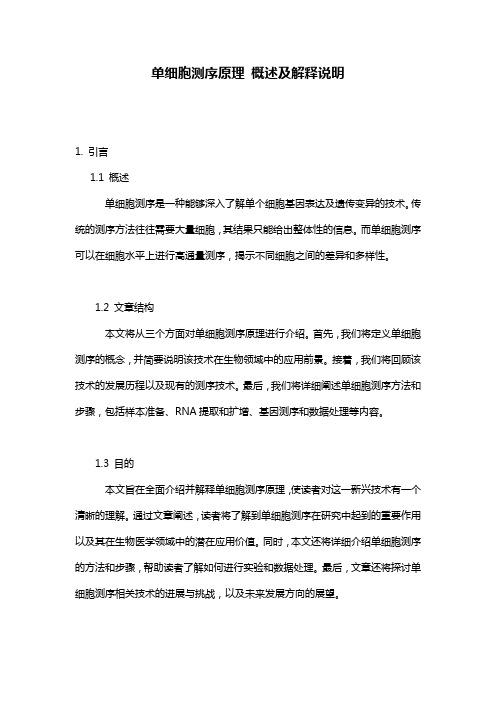
单细胞测序原理概述及解释说明1. 引言1.1 概述单细胞测序是一种能够深入了解单个细胞基因表达及遗传变异的技术。
传统的测序方法往往需要大量细胞,其结果只能给出整体性的信息。
而单细胞测序可以在细胞水平上进行高通量测序,揭示不同细胞之间的差异和多样性。
1.2 文章结构本文将从三个方面对单细胞测序原理进行介绍。
首先,我们将定义单细胞测序的概念,并简要说明该技术在生物领域中的应用前景。
接着,我们将回顾该技术的发展历程以及现有的测序技术。
最后,我们将详细阐述单细胞测序方法和步骤,包括样本准备、RNA提取和扩增、基因测序和数据处理等内容。
1.3 目的本文旨在全面介绍并解释单细胞测序原理,使读者对这一新兴技术有一个清晰的理解。
通过文章阐述,读者将了解到单细胞测序在研究中起到的重要作用以及其在生物医学领域中的潜在应用价值。
同时,本文还将详细介绍单细胞测序的方法和步骤,帮助读者了解如何进行实验和数据处理。
最后,文章还将探讨单细胞测序相关技术的进展与挑战,以及未来发展方向的展望。
2. 单细胞测序原理:2.1 单细胞测序的定义:单细胞测序是一种基因组学研究方法,它可以在单个细胞级别上分析其DNA或RNA的序列。
传统的基因测序方法通常是对大量细胞进行测序,从而获得平均表达水平或突变频率等整体信息。
与之相反,单细胞测序使我们能够了解每个单个细胞的遗传信息和功能特征,可以揭示不同细胞类型之间的异质性。
2.2 测序技术的发展历程:随着高通量测序技术的快速发展,单细胞测序也得到了长足地进展。
最初,单细胞测序主要使用PCR扩增来获得足够数量的DNA或RNA以进行后续测序分析。
然而,这种方法存在偏差和错误放大等问题。
近年来,出现了许多新兴的单细胞测序技术,如SMART-seq、MARS-seq、DroNc-seq和10x Genomics等。
这些技术利用微流控芯片、体积限制及其他改良步骤来提高PCR扩增效率和减少偏差。
2.3 单细胞测序的应用领域:单细胞测序广泛应用于生命科学的多个领域。
单细胞测序(测序公司培训)PPT精选文档

扩增引物 Phi 29 DNA聚合酶 基因组模板DNA
MALBAC法扩增
PicoPLEX™ WGA Kit
单细胞转录组
12
13
14
单细胞测序
主讲人:陈璟 2015/8/5
2013年,单细胞测序技术(single-cell sequencing)荣膺《自然-方法》年度 技术。单细胞测序技术有助于我们剖 析细胞的异质性。它可以揭示肿瘤细 胞基因组中发生的突变及结构性变异, 而这些突变和变异往往有着极高的突 变率。
2
3
4
MDA扩增图
15
16
171819 Nhomakorabea 2021
单细胞CNV(Copy number variation)分析
22
单细胞SNV(single nucleotide variation)分析
23
24
测序技术.ppt

(一)随机测序法
随机测序法(random approach)包括鸟枪法与人 工转座子法。其共同特点是无特定方向性,随机 对靶DNA进行测序,最后通过计算机拼装而得到完 整的序列信息。
(二)非凝胶基质毛细管电泳
为了避免CGE存在的问题,非凝胶基质毛细管电 泳用于DNA分析的研究越来越多,常见的有线性 聚丙烯酰胺和纤维素衍生物等非凝胶基质,这些 非凝胶基质在DNA测序中可以更换,使毛细管的 寿命延迟,在优化条件下可获得高效及高速的分 离效果。
(三)阵列毛细管电泳
阵 列 毛 细 管 电 泳 ( Capillary array electrophoresis, CAE)是将毛细管电泳与板凝 胶电泳的优势相结合,采用毛细管凝胶电泳的装 置,将多支毛细管进行并列进行分离与检测,以 板凝胶电泳的优势弥补了毛细管凝胶电泳的不足, 可一次检测多个样品。
人类基因组计划是当代生命科学一项伟大的 科学工程,它奠定了21世纪生命科学发展和现代 医药生物技术产业化的基础,具有科学上的巨大 意义和商业上的巨大价值。
经典方法 新技术方法
Sanger双脱氧链终止法(Sanger和 Coulson1977) Maxam-Gilbert DNA化学降解法 (Maxam 和Gilbert,1977)
通用引物的长度一般为15~30个核苷酸。
(三)DNA聚合酶
1.大肠杆菌DNA聚合酶I大片段(Klenow片段) Klenow片段酶是Sanger法最早使用的DNA聚合
酶,具有5′→3′聚合酶和3′ → 5′外切酶 活性,但它催化链延伸反应的能力较差,用它 进行测序常产生较高的本底测序技术
单细胞基因测序
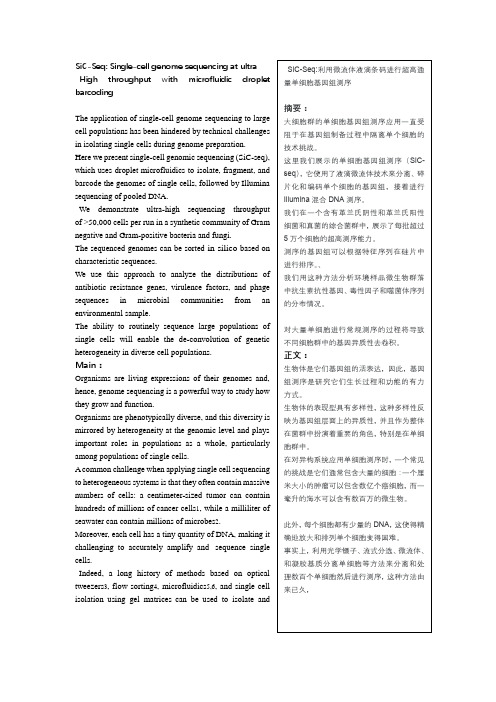
Highthroughput with microfluidic dropletbarcodingThe application of single-cell genome sequencing to large cell populations has beenhindered by technical challenges in isolating single cells during genome preparation. Herewe present single-cell genomic sequencing (SiC-seq), which uses droplet microfluidics toisolate, fragment, and barcode the genomes of single cells, followed by Illumina sequencingof pooled DNA.We demonstrate ultra-high sequencing throughput of >50,000 cells per runin a synthetic community of Gram negative and Gram-positive bacteria and fungi. Thesequenced genomes can be sorted in silico based on characteristic sequences.We use thisapproach to analyze the distributions of antibiotic resistance genes, virulence factors, andphage sequences in microbial communities from an environmental sample.The ability toroutinely sequence large populations of single cells will enable the de-convolution of geneticheterogeneity in diverse cell populations.Main:Organisms are living expressions of their genomes and, hence, genome sequencing is apowerful way to study how they grow and function.Organisms are phenotypically diverse,and this diversity is mirrored by heterogeneity at the genomic level and plays important rolesin populations as a whole, particularly among populations of single cells.A commonchallenge when applying single cell sequencing to heterogeneous systems is that they oftencontain massive numbers of cells: a centimeter-sized tumor can contain hundreds of millionsof cancer cells1, while a milliliter of seawater can contain millions of microbes2.Moreover,each cell has a tiny quantity of DNA, making itchallenging to accurately amplify andsequence singlecells.The sparseness of the sampling limits the questions that canbe addressed, with the majority of findings relating to the most abundant subpopulations. Amethod that could markedly increase the number of cells sequenced at the single cell levelwould impact a broad range of problems across biology where heterogeneity is important.Droplet microfluidics enables millions of independent picoliterreactions, and has recentlybeen used to deep sequence single DNA molecules10, tag nucleosomes to enable single-cellChIP-seq11, and to profile the transcriptomes of single cells all at high throughput. However, sequencing the genomes of single cells presents unique challenges, becausegenomic DNA must be purified from the cellular matter and processed through a series ofenzymatic steps to prepare it for sequencing.Consequently, while droplet microfluidicsprovides the potential for sequencing of single cell genomes at ultra high-throughput, noapproach for accomplishing this has yet been described.We describe a method for single cell genome sequencing at ultrahigh-throughput (SiC-seq)using droplet microfluidics.In SiC-seq, we encapsulate cells in hydrogel microspheres(microgels) that are permeable to molecules with hydraulic diameters smaller than the poresize, including enzymes, detergents, and small molecules, but sterically trap large moleculessuch as genomic DNA.This allows us to use a series of “washes” on encapsulated cells, toperform the requisite steps of cell lysis and genome processing, while maintainingcompartmentalization of each genome.Using a combination of microgel andmicrofluidicprocessing steps, we lyse the cells, fragment the genomes, and attach unique barcodes toallfragments, in a workflow that processes >50,000 cells in a few hours.pooled and sequenced,and the reads grouped bybarcode,providing a library of single cell genomesthat can be subjected to additionaldownstreamprocessing, including demographiccharacterization and in silico cytometry (Fig. 1ResultsSiC-seq workflowThe principal strategy of SiC-seq is to label all DNAfragments originating from the samegenome with asequence identifier (barcode) unique to that cell.The resultant products arechimeric, comprising abarcode sequence covalently linked to a randomfragment of the cellgenome.The barcodes allow all reads belonging to a givencell to be identified throughshared sequence.We use libraries of barcode droplets containing thebarcode sequences thatare merged with the genomecontaining droplets to be barcoded10.To prepare a barcodedroplet library, we encapsulateinto droplets at limiting dilution, oligonucleotidescomprising15 random bases flanked by constantsequences with PCR reagents andprimerscomplementary to the constant regions of thebarcodes with one side containing the IlluminaP7flow cell adapter (Fig. 2a)16.The droplets are then thermal cycled to amplify thebarcodesequences via digital droplet PCR, generating~10 million barcode droplets in a few hours.Before the single cell genomes can be barcoded, theymust be physically isolated, purified,and fragmented.To accomplish this, we encapsulate single cells inagarose microgels usinga two-stream co-flow dropletmaker, which merges a cell suspension stream with amoltenagarose stream, forming a droplet consistingof an equal volume of both streams (Fig. 2b andSupplementary Fig. 1a).The droplet maker runs at ~10 kHz, allowing us togenerate~10 million ~22 μm diameter droplets in ~20minutes in a total volume of aqueous emulsionof ~60μL.Hence, droplet generation is fast and the total volume consumed small, allowingus to load cells at a rate of 1:10 to minimize multi-cell encapsulation.microgels are then transferred from oil to aqueouscarrier phase to besubjected to cell lysis and genomepurification.To lyse the cells, we incubate the microgelsovernightin a mixture of lytic enzymes, digesting theprotective microbial cell walls (Onlinemethods).We then incubate them in a mixture of detergents andproteases for 30 minutes,solubilizing lipids and digesting proteins, preservingonly high molecular weight genomicDNA, which weverify by staining with SYBR green dye (Fig. 2c).To fragment the genomesand attach the universalsequences to act as PCR handles, we re-encapsulatethe gels in theNextera® reaction (Fig 2dandSupplementary Fig. 1b).Because the transposases aredimeric, the fragmentedgenome remains intact as a macromolecular complex,remainingsterically encased within the hydrogelnetwork (Supplementary Fig. 2) 17.Nevertheless, were-encapsulate the gels into separatedroplets during fragmentation to ensure that there isnocross-contamination of DNA between the gels.After the genomes are purified and fragmented, theyare barcoded for sequencing.We use amicrofluidic device that merges eachmicrogel-containing droplet with dropletscontainingPCR reagents and a barcode droplet (Fig.2e andSupplementary Fig. 1c).The resultingdroplets, which containfragmented-genome and barcode DNA are collectedinto a PCR tubeand thermal cycled, splicing thebarcode sequences onto the genomic fragmentsviacomplementarity through the PCR handles addedby the transposase.At this point, thespliced fragments contain both theP5 and P7 Illumina sequencing adaptor requiredforsequencing on the Illumina platforms.We remove droplets that coalesce duringthermalcycling using a micropipette, then theremaining droplets are chemically merged andtheircontents pooled and prepared for sequencing(Online methods).Validation of SiC-seq on an artificial microbial communityThe objective of SiC-seq is to provide single cell genomic sequences bundled in barcodegroups.To validate that SiC-seq generates single cell barcode groups, we applied it to anartificial microbial community containing three Gram-negative bacteria, five Gram-positivebacteria, and two yeasts, which are typically difficult cell types to lyse.We prepared asingle-cell library from this community using SiC-seq and sequenced it on an IlluminaMiSeq, yielding ~6 million single-end reads of 150 bp after quality filtering.We groupedreads by barcode and discard groups with < 50 reads yielding the final 48,989 barcodegroups (Fig. 3a).Each barcode group represents a low-coverage genome of a cell, with asequencing depth of ~0.1% to ~1% (Supplementary Fig. 3)To determine whether the barcode groups indeed correspond to single cells, we mapped allreads to the reference genomes of the ten species.If two microbes reside within the samebarcode group, reads will map to two genomes.We defined a group purity score as thefraction of reads mapping to the most mapped reference (the ideal barcode group has apurity score of 1.0).The distribution of purity scores is strongly skewed to high values withthe majority of purity score over 0.95 suggesting that most barcode groups represent singlecells; this result is consis;tent even taking into account the different genome sizes of the tenspecies (Fig. 3b and Supplementary Fig. 4) as well as when purity is examined individuallyfor each species(Supplementary Fig. 5).To determine whether SiC-seq barcodes abundances reflect the organism abundances in thedataset, we compared abundance estimates calculated via short-read alignment, k-mer basedsequence classification, and counting under bright-field microscopy (Fig 3 andSupplementary Fig. 7).We found that all methods are in reasonable agreement when readsare pooled and analyzed in bulk and when species identities are assigned to each barcodebased on the most commonly mapped species in a group.This demonstrates that SiC-seqenables estimation of species abundance in a microbial population consistent with acceptedmetagenomic methods. Sequencing the genome of a single cell typically incurs coverage distribution bias18 due touneven amplification of DNA starting from a single genome copy.To investigate coveragedistribution bias in SiC-seq, we plotted the normalized coverage distribution for readsaggregated from all barcode groups for each microbe (Fig. 3d, 3e, and Supplementary Fig.8). With the exception of coverage gaps due to low abundances of cells of certain specieswithin the standard microbial community, we observed no substantial coverage bias.Thisindicates that the sampling of each genome within a barcode group is random, so that whenall groups are overlaid, a uniform distribution is obtained.We further inspected thedistribution of reads in individual barcode groups and found no substantial bias(Supplementary Fig. 9). We believe thatcoverage bias is minimal because each genomeisamplified in a tiny volume of ~65 pL, which has been shown to curtail bias-inducingrunaway of exponential amplification19.amplified genomes, the amplification of each genomecan be limited by the tinyvolume while still producingsufficient total DNA for sequencing.SiC-seq data analysis with in silico cytometryThe genomic sequences generated using SiC-seq aregrouped according to single cells,which iscomplementary to the sequences generated fromshotgun metagenomic sequencing.Existing computational tools are ill-suited to analyzethese data because they do not exploitthe single cellbarcode information unique to SiC-seq.To address this, we utilize a sequenceanalysis pipelinein which reads are organized hierarchically as barcodegroups, generating aSingle Cell Reads database(SiC-Reads) (Supplementary Fig. 10).To build SiC-Reads, wefilter raw sequences by quality,group them by barcode, and estimate ataxonomicclassification of each group usingphylogenetic profilers.We also estimate a purity scoreequal to the fraction ofreads mapping to the dominant taxon within theclassifiable set.Additional properties of barcode groups and reads,such as presence of sequencescorresponding toantibiotic resistance genes, can be added to thedatabase as they arediscovered during analysis.The massive set of single cell genomes present inSiC-Reads provides new opportunities fordiscoveringassociations between sequences within single cells, ina process we dub in silico cytometry.SiC-Reads comprises a collection of single cellgenomes that can be sorted insilico, analogous towhat is commonly done with flow cytometry onsingle cells. Thedatabase can be sorted repeatedly tomine for correlations between differentgeneticsequences and structures. Moreover, as newassociations are learned, new sorting parameterscanbe defined, enabling discoveries without having torepeat the experiment.resistance in microbesTo demonstrate in silico cytometry, we used SiC-seq to sequence a microbial community recovered from coastal seawater of San Francisco (Online methods). We obtained ~8 millionreads of 150 bp length after quality filtering(representing of ~55% of raw reads), withwhich we generated a SiC-Reads database(Supplementary Fig. 10). Using a phylogeneticprofiler, 601,348 (6.89%) of reads werebacteria, 0.04% archaea, and 0.16% viruses (Supplementary Fig. 11a). Barcode groups were assigned a taxonomic classification based on the reads they contained, following the rulethat more than 10% of reads in a barcode group must be classified, and the assigned classification is the taxon with the most supporting reads. Most barcode groups were high purity based on the classifiable sequences (~91% average), in accordance with our controlsample (~94% average) (Supplementary Fig. 11b). Using this SiC-reads database, we demonstrate in silico cytometry by exploring the distribution of antibiotic resistance,virulence factors, and phage sequences in the microbial community.Antibiotic resistance has become increasingly common and represents a significant threat to global human health20. While antibiotic resistance genes can be identified in mostenvironments by short-read sequencing, scant information on how they are distributedamong taxa is available, because obtaining this information usually requires testing or whole genome sequencing of single species; however, culture conditions for most species have notbeen identified, precluding such analyses.To determine the distribution of antibiotic resistance genes among taxa in our dataset, we searched our SiC-Reads database for known antibiotic resistance genes, finding 1,081(0.012% of reads), representing 108 (0.30%) ofbarcode groups. The taxonomic distributionof antibiotic resistance genes in our database has a clear structure, although it does notcorrelate with what is known from genomes in public databases (Fig. 4a and SupplementaryFig. 12a). This is unsurprising as differences are expected in the natural coastlineenvironment compared to the environment of isolated and sequenced strains. The mostabundant taxa associated with antibiotic resistance Array are not the most abundant communitymembers overall, suggesting that in this communitycertain taxa tend to associate more withantibiotic resistance genes.Association of virulence factors with hostbacteriaVirulence factors, like antibiotic resistance genes, areimportant genetic factors indetermining the threat that specific microbes pose tohuman health. Many opportunisticpathogens reside in natural communities in theenvironment and cause outbreaks whentransmitted to a suitable host21. Monitoring anddetecting potentially pathogenic microbes isimportant for public health. Like antibioticsresistance genes, traditional methods can detectthe presence of these genes but not their taxonomicdistribution.To examine the taxonomic distribution of virulencefactors in our dataset, we searched ourcoastal microbial community database for knownvirulence factor genes, yielding matches in1,949 (0.022%) reads in 101 (0.28%) barcode groupsconsisting of 29 prevalent virulencefactors distributed among 13 microbial genera. Theabundances of taxa where virulencefactors were found did not reflect that of the totalpopulation, suggesting that certain generatend to carry more virulence factors than others. Toquantify this, we calculated the virulencefactor ratio, the ratio between the number of barcodegroups containing virulence factors andthe total number of barcodes in the community forthat species, and normalized the results tothe highest virulence factor ratio for comparison (Fig.4b). Haemophilus and Escherichiastand out amongst all species, both of which areknown opportunistic human pathogens.Comparing the virulence factor ratios of the San Francisco coastline community with ones calculated for publicly-available whole genomes, and down sampled to match our per-cellread depth (Supplementary Fig. 12b), we found that the ratios are higher for the publicgenomes, an expected result given that isolated and sequenced genomes are are biasedtowards pathogenic strains.Determining transduction potential between bacteriaMany virulent bacterial strains are thought to arise from horizontal gene transfer aided bycross-infection of bacteriophages. Phages can modify the genomes of their hosts, leaving acopy of their own genome behind or transporting fragments of one species to another in aprocess known as transduction22,23. Characterizing the distribution of these mobile elementsis challenging in an ecological context because confident identification of foreign genomic fragments within a specific host requires sequencing large numbers of cultures of singlespecies or single cells. Nevertheless, this information is valuable for understanding howbacteria transfer genetic material in general, and how virulent new strains may emerge viathis mechanism.To explore transduction in the microbial community, we searched the SiC-Reads database ofthe San Francisco coastal community for barcode groups containing phage sequences. Aphage sequence found in a bacterial genome is evidence of infection, an association that isnormally extremely difficult to make for uncultivable microbes and their likely uncultivableinfecting phages. We found matches in 6,805 (0.078%) reads representing 260 (0.72%)barcode groups and 106 phage genomes. Since transduction can occur between two hostcells that can be infected by the same phage, the potential for transduction depends on thelikelihood of phages infecting both hosts. To visualize this, we plot the normalized sum ofthe number of times we detect the sequences matching to the same phage in two bacterialtaxa, normalized by the number of barcode groups in those taxa (Fig. 4c). According to this analysis, Delftia and Neisseria, which are closest related out of the taxa in our analysis, havethe highest potential for transduction. The dearth of representative phage genomes indatabases and the limited sequence information per barcode group, limits the accuracy ofthis approach. Therefore, higher coverage of the genomes and better phage genomedatabases are required to definitively identify the phages that are found in the database. Nevertheless, SiC-seq‟s ability to detect these sequences and correlate them within singlegenomes can provide a useful approach to studying phage-host interactions.DiscussionSiC-seq generates a metagenomic database grouped by single cell genomes amenable torepeated mining via in silico cytometry, for rapid hypothesis generation and testing. Wedemonstrated its use in measuring the distributions of antibiotic resistance genes, virulencefactors, and transduction potential in microbial communities. The ability to sequence allcells in a sample without the need to culture is a powerful aspect of SiC-seq that should aidin our ability to characterize t he …microbial dark matter‟.The barcoded nature of SiC-seq data necessitates additional quality control of measures forthe data, in addition to the quality control measures utilized in standard sequencing. First,the barcode reads themselves must be of high quality, thus eliminating any reads containinglow quality barcode sequences, regardless of the quality of the genomic sequences. Second,barcode groups must be quality controlled to remove small-sized barcode groups, which arethe result of mutations in the barcode sequences and background contamination of freeDNA. These quality control measures together resultin a typical yield of ~55% of raw readscontributing to the SiC-reads database. Improvements in yield can be made by, for example,computationally ident ifying reads with mutated barcodes …correcting‟ their sequence, but wehave found only modest improvements in yields using this method alone10.The taxonomic classification of microbes remains an integral part of studying communitydynamics, from ecosystems on Earth to those residing in and on our bodies24,25. However,the taxonomic classification of short reads is error prone, due to the diversity of microbes inmost communities and the high degree of horizontal gene transfer that mixes genomicelements in unpredictable ways. SiC-seq improves upon traditional metagenomicssequencing in addressing this challenge because taxonomic identification can be made basedon hundreds of reads within a barcode group. Advanced strategies can be applied to estimatetaxonomy of a barcode group, including Bayesian probabilistic ones based on classificationof each read in the group, or ones weighted towards specific taxonomic markers. With eventhis improvement, accurate classification is difficult because the vast majority of sequencesremain unclassifiable and the classification of sequences are biased towards well-sequencedtaxa in the databases. As genome coverage improves in future iterations of SiC-seq,taxonomic classification of barcode groups should become more confident and precise,potentially arriving at strain level classifications under certain circumstances. It is worthnoting that taxonomic classification with SiC-seq is also subject to the fundamentallimitations of reference based classification paradigms where the classification is only asaccurate as the match between the sample and the references. Hence, like traditionalmethods, SiC-seq phylogenetic profiling will become more reliable and complete with theexpanding database of reference genomes.The degree of genome coverage impacts the usefulness of single cell data, including theability to generate assemblies or identify characteristic sequences for in silico cytometry. Alimitation of SiC-seq is that, while the number of cells sequenced far exceeds currentlydescribed methods, the coverage per cell is significantly lower. Therefore, dropouts incoverage and false negatives can be expected in in silico cytometry analysis. For abundantorganisms with a random distribution of coverage in each barcode group, the system isrobust to dropouts because results are averaged over many barcode groups. For example,approximately 7,000 Alteromonas barcode groups were taken into account to determine theantibioticresistance profile for Alteromonas bacteria. However, for less abundant species,such as Haemophilus, more dropouts can be expected because there may not be enough totalsequence information to detect a specific genetic factor. For this reason, the analysis of SiCreads databases should be limited to relative comparisons of species within the database, andthe abundance of target genes within subpopulations should be normalized to the number ofbarcode groups in the subpopulation. It is worth noting that the dropout phenomenon is notunique to SiC-seq data, but all metagenomic sequencing data where the subpopulation to beanalyzed represents a very small fraction.Although coverage can be increased by sequencing more reads, the coverage per cell perbarcode group will be below 100%. This is because the method begins with a single genomecopy without amplification and losses incurred during enzymatic and microfluidicprocessing are irrevocable, thus limiting the maximum coverage attainable. In futureiterations of SiC-seq, coverage may be increased by pre-amplifying genomes prior toprocessing, for example, with multiple displacement amplification in droplets7. Additionally,different strategies for barcoding genomes may yield higher coverage, such as recentlydescribed combinatorial indexing via transposase libraries40, which should be applicable tosingle cell genomes encapsulated in microgels.The de novo assembly of whole genomes from metagenomics sequences is a common goalin the field of metagenomics. Mate-paired sequencing can be used to bridge contigs inametagenomics sequencing dataset and potentially assemble whole genomes given sufficientcoverage26. Though powerful, the method is limited by the required micrograms of startingDNA that can be difficult to obtain from microbial ecosystems. Furthermore, many matepaired reads are required to assemble a whole genome, since each mate-pair bridges onlytwo contigs. SiC-seq data improves on mate-paired sequencing in this respect by requiringminimal amounts of sample as well as enabling the bridging of multiple contigs per barcodegroup. Consequently, SiC-seq should allow generation of draft genomes from shotgunmetagenomic data with far less DNA input requirement and sequencing effort.While we focused on microbial communities, SiC-seq is also applicable to populations ofmammalian cells, where it can have a more direct impact on human health. The groupedreads provided by SiC-seq should afford the information required to determine copy-numbervariations within the genome, which is relevant to cancer27. The enormous size ofmammalian genomes, however, limits the number of cells that can be sequenced for a targetlevel of coverage. Nevertheless, as the cost of sequencing continues to decrease, more cellscan be sequenced to greater depth, creating opportunities for characterizing mammaliantissues, cell-by-cell.SiC-seq method is a means to isolate and barcode large DNA molecules, irrespective of theentity from which they originate. While we have focused on cells, similar approaches can beapplied to any entities whose genomes can be trapped and processed within the gel matrix.SiC-seq‟s ability to build and mine large databases of genomes grouped by single cellsshould contribute to the characterization of heterogeneity across biology.。
单细胞测序

单细胞测序
单细胞测序:
单细胞测序是指DNA研究中涉及测序单细胞微生物相对简单的基因组,更大更复杂的人类细胞基因组。
细胞是生物学的基本单位,研究人员正更加努力地尝试将它们进行单个分离、研究和比较。
更大更复杂的人类细胞基因组。
随着测序成本的大幅度下降,破译来自单细胞的30亿碱基的基因组并逐个细胞比较序列正在变为现实。
目前,最常见的单细胞测序的应用是在肿瘤研究上。
来自美国和英国的研究人员近日利用单细胞基因组扩增、测序和装配,从海洋样本中鉴定出一个单细胞细菌。
单细胞测序的知识

单细胞测序的知识介绍Bulk RNA-seq:测量一个大的细胞群体中每一个基因的平均表达水平,对比较转录组学(例如比较不同物种的相同组织)是有帮助的,但对于研究异质性系统(例如,复杂的组织如脑)还是不够的,对于基因表达的本质研究不够深入scRNA-seq:2009年由Tang发表,但直到14年才降低测序费用,逐渐进入大家的视野。
它测定的是细胞种群中每个基因的表达量分布,对于研究特定细胞转录组的变化是重要的。
测定的细胞量也由最初的102涨到了106 并且还在递增,向着高通量的方向发展。
现在有许多处理单细胞测序的流程,比如13年的SAMRT-seq2,12年的CELL-seq,15年的Drop-seq。
有一些做单细胞的平台,包括Fluidigm C1、Wafergen ICELL8、10X Genomics Chromium。
发展历史单细胞测序的流程:测序流程看着和普通的mRNA转录组差不多,取材要求更高了分析流程黄色部分对于高通量数据的处理都是差不多的流程;橙色的部分需要整合多个转录组分析流程以及显著性分析,来解决单细胞测序的技术误差;最后是下游表达量、通路、互作网络等生物类别的分析,需要使用针对单细胞研发的方法可以借助许多工具:•Falco [云端处理流程]•SCONE(Single-Cell Overview of Normalized Expression)—一个质控和标准化的包•Seurat-- QC以及后续分析探索数据•ASAP(Automated Single-cell Analysis Pipeline) —交互式网页分析面临挑战:单细胞转录组与群体转录组的最大不同之一就是:测序文库是建立在单独一个细胞上的,并非一群细胞。
单细胞目前面临的挑战主要是:扩增量目前最多是一百万个细胞;有可能一个基因在一个细胞中能检测到中等表达量,但是在另一个细胞中却检测不到,这种现象叫做"gene dropouts"。
- 1、下载文档前请自行甄别文档内容的完整性,平台不提供额外的编辑、内容补充、找答案等附加服务。
- 2、"仅部分预览"的文档,不可在线预览部分如存在完整性等问题,可反馈申请退款(可完整预览的文档不适用该条件!)。
- 3、如文档侵犯您的权益,请联系客服反馈,我们会尽快为您处理(人工客服工作时间:9:00-18:30)。
扩增引物 Phi 29 DNA聚合酶 基因组模板DNA
MALBAC法扩增
PicoPLEX™ WGA Kit
单细胞转录组
12
13
14
15
16
17
CNV(Copy number variation)分析
22
单细胞SNV(single nucleotide variation)分析
23
24
单细胞测序
主讲人:陈璟 2015/8/5
2013年,单细胞测序技术(single-cell sequencing)荣膺《自然-方法》年度 技术。单细胞测序技术有助于我们剖 析细胞的异质性。它可以揭示肿瘤细 胞基因组中发生的突变及结构性变异, 而这些突变和变异往往有着极高的突 变率。
2
3
4
MDA扩增图
